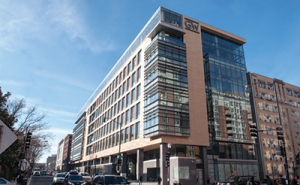The George Washington University (GW) recently opened the doors to its newest campus facility at the corner of 22nd and H streets: the 500,000-square-foot, multidisciplinary Science and Engineering Hall (SEH). The sparkling 14-floor building — eight floors above ground and six below — located across the street from Ross Hall doubles the amount of space available to GW’s science and engineering disciplines on the Foggy Bottom campus and serves as a technological hub for the university. When the top two floors are completed in 2016, the $275 million facility targeting LEED Gold certification will house state-of-the-art cancer research labs on the 8th floor that will be run by the School of Medicine and Health Sciences (SMHS).

The building will bring together faculty from GW’s Columbian College of Arts and Sciences, the School of Engineering and Applied Science, the SMHS, and the Milken Institute School of Public Health.
“The SEH opens the door to even greater opportunities for research and discovery in health and medicine at GW,” says Jeffrey S. Akman, M.D. ’81, RESD ’85, Walter A. Bloedorn Professor of Administrative Medicine, vice president for health affairs, and dean of SMHS. “In the new space, SMHS will expand its research capabilities in the area of cancer and translational science, building bridges between the lab and the clinic to deliver novel therapies to patients.”
Among the wet and dry laboratories, teaching labs, common areas, and administrative and faculty office space, researchers in the facility will share four specialized labs: a three-story “high bay” for large-scale experiments; a nanofabrication lab, which is a Class 100 clean-room environment used to develop and test devices including the next generation of transistors and state-of-the-art biosensors for cancer detection; a climate-controlled rooftop greenhouse; and an imaging suite equipped with microscopes capable of viewing objects at resolutions better than one-billionth of a meter.
Roughly 85 percent of the power used in the SEH is generated by a green co-generation utility plant located in Ross Hall, which recycles steam to generate electricity and heat for both buildings. The new power system will cut the facility’s carbon dioxide emissions by more than 8,100 metric tons each year; this is equal to taking nearly 1,500 vehicles off the road.



